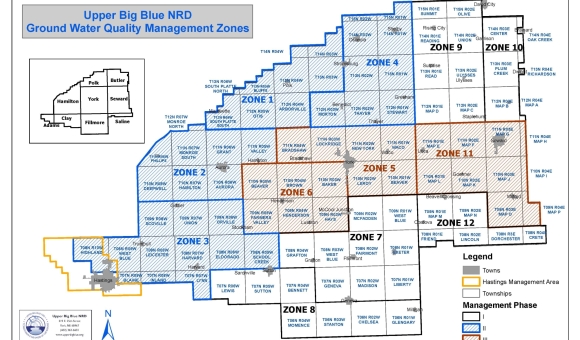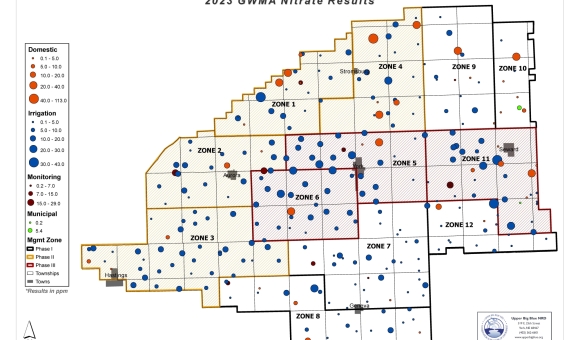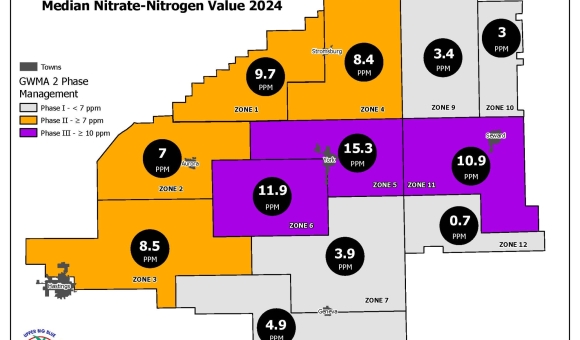Nitrogen Management
Increasing nitrates in groundwater have been a concern in the Upper Big Blue NRD for many years. Several communities in the district have found it necessary to construct new wells to comply with state and federal drinking water standards. Some communities have built, or are considering, treatment plants. Many rural residents have also replaced wells or installed private water treatment systems.
Nitrate is found naturally in the environment, however excess nitrates that are causing groundwater contamination come primarily from the use of commercial fertilizers. Nitrogen fertilizer is needed to produce corn, however, the amount and timing of the fertilizer application can reduce the risks of groundwater contamination.
Since 1996, the NRD has required that farmers wait until November 1st to apply anhydrous and to wait until March 1st to apply other formulations of nitrogen fertilizer. In some parts of the district where groundwater nitrate is the highest (see map on reverse side), farmers are required to attend training classes, take soil samples, and calculate crop nitrogen needs. Despite these efforts, groundwater nitrate levels have continued to rise. The NRD encourages producers to adopt fertilizer management practices that will reduce the chance of nitrate leaching out of the crop root zone and use other strategies, such as cover crops, to sequester residual nitrogen, holding it in the soil.
To find dates and locations for our nitrogen management training events, please visit our events tab.
Nitrification Inhibitors
A nitrification inhibitor is a chemical compound used to slow the nitrification of ammonia, ammonium-containing, or urea-containing fertilizers, which are applied to soil as fertilizers. These inhibitors can help reduce losses of nitrogen in the soil that would otherwise be used by crops.
For the purpose of these regulations, a nitrification inhibitor must include one of the following active ingredients Nitropyrin, Pronitridine, or Dicyandiamide. Requests for additions to the list of approved nitrification inhibitor active ingredients will be considered by the board upon request.
In Phase III management areas and Hastings Wellhead Protection Groundwater Management Area, if anhydrous ammonia is applied between November 1 and February 29, a district-approved, active ingredient containing, nitrification inhibitor must also be applied at the manufacturer’s recommended rate. A receipt as proof of purchase for the nitrification inhibitor must accompany the producer's Phase II/III annual report.
Nitrate Management Zones
Changes to District Rule 5 for setting the trigger levels in Phase II and Phase III management areas went into effect on February 1, 2013. The Phase II trigger is 7 milligrams per liter (mg/l).
Phase II producers are required to use electrical resistance blocks or capacitance probes to schedule irrigation in one field. Scheduling irrigation using soil moisture information can reduce the risk of excess irrigation leaching nutrients from the root zone. In a Phase II Management Area, producers are also required to take deep (24”) soil samples for residual nitrate in a corn field where corn will be planted again. It also requires producer training and annual reporting of management practices.
Increasing nitrates in groundwater have been a concern in the Upper Big Blue NRD for several years. Several communities in the District have found it necessary to construct new wells to comply with state and federal drinking water standards. Some communities have built, or are considering, treatment plants. Many rural residents have also replaced wells or installed private water treatment systems.
Nitrate is found naturally in the environment, however excess nitrates that are causing groundwater contamination come primarily from the use of commercial fertilizers. Nitrogen fertilizer is needed to produce corn, however, the amount and timing of the fertilizer application can reduce the risks of groundwater contamination.
Since 1996, the NRD has required that farmers wait until November 1st to apply anhydrous and to wait until March 1st to apply other formulations of nitrogen fertilizer. In some parts of the District where groundwater nitrate is the highest, farmers are required by existing regulations to attend training classes, take soil samples, and calculate crop nitrogen needs. Despite these efforts, groundwater nitrate levels have continued to rise.
Soil Sampling
Phase II Soil Sampling Requirements:
Soil samples are required in years when corn or sorghum will be grown following a non-legume crop and/or when livestock, municipal or industrial waste has been applied within the last 12 months.
A minimum of:
- 1 composite 0-8” sample per field analyzed for organic matter and residual nitrogen, and
1 composite 8-24” sample per field analyzed for residual nitrogen is required.
For soil sampling purposes, a field is defined as one where the crop and irrigation practices are the same.
Phase III Soil Sampling Requirements:
Soil samples are required in years when corn or sorghum will be grown following a non-legume crop and/or when livestock, municipal or industrial waste have been applied within the last 12 months.
A minimum of:
- 1 composite 0-8” sample per 40 acres or any portion thereof, analyzed for organic matter and residual nitrogen
- 1 composite 8-24” sample per 40 acres or any portion thereof, analyzed for residual nitrogen is required.
Nitrogen Regulation (Rule 5 Summary)
Phase I
This Phase applies to the entire NRD. Anhydrous ammonia may not be applied for spring-planted row crops until November 1 each year. Other forms of nitrogen fertilizers may not be applied until March 1. (Exemptions: fertilizing of non-row crops such as wheat, rye, oats, pasture, etc.). The application of manure, municipal sludge or industrial waste must be in compliance with state regulations. The application of fertilizers when nitrogen is not the largest percentage of the formulation and the total nitrogen applied per acre is less than 25 lbs.
Phase II
This Phase applies to areas where the NRD has determined that the median groundwater nitrate level exceeds 7 parts per million. Requirements include: Phase I requirements continue; Producers must attend nutrient management training once every 4 years; Shallow and deep soil sampling to depths of 8 inches for nitrate and organic matter and 24 inches for residual nitrate is required for fields where corn or sorghum follow corn or sorghum; Electrical resistance blocks or capacitance probes used to measure soil moisture must to installed by each farm operator to schedule irrigation in at least one field; and, reports on fertilizer and irrigation management practices must be submitted annually.
Phase III
This Phase applies to areas where the NRD has determined that the median ground-water nitrate level exceeds 10 parts per million. Currently, three Zones of the district are in Phase III management. Phase III Requirements include: Phase I and II requirements continue; Soil sampling as described in Phase II must be done on a maximum of 40-acre grids; and, irrigation water sampling for nitrates is required; irrigation water from each active irrigation well must be tested once every three years for nitrates; and a district-approved nitrification inhibitor must be applied at the manufacturer’s recommended rate if nitrogen fertilizer is applied prior to March 1. N-Serve is the only district-approved nitrification inhibitor.
Additional Resources
Phase Requirements (Detailed)
Phase I Requirements –
All operators within the district are subject to the requirements of Phase I.
- Fall Applied Anhydrous Ammonia
Application of anhydrous ammonia before November 1 is prohibited. - Pre-Plant Liquid or Dry Nitrogen Formulations
Pre-plant nitrogen applications in liquid or dry forms are prohibited before March 1.
Exemptions to Items 1 & 2
- The application of nitrogen fertilizer for any purpose other than fertilizing spring planted crops.
- The application of nitrogen fertilizer for spring planted small grains such as barley, oats and rye.
- The application of fertilizer that is not considered a “nitrogen fertilizer” as defined in Rule 5 of the District Groundwater Management Rules and Regulations.
- The spreading of manure, sewage and other by-products, conducted in compliance with state laws and regulations.
Phase II Requirements –
All operators of land within district Management Zones 1, 2, 3, 4, 5, 6, and 11 are subject to the requirements of Phase II. Refer to the map on page 3 for management areas. Phase II operators are required to follow all Phase I requirements in addition to the following:
- Nitrogen Certification Training
Farm operators must attend a nitrogen certification training once every 4 years. - Irrigation Scheduling
Irrigation scheduling equipment is required in at least one field in a Phase II area. The equipment should be installed in the largest field you operate. Examples are:
Capacitance Probes
Resistance Blocks
Other methods approved by the District - Soil Sampling Requirements
Soil samples are required in years when corn or sorghum will be grown following a non-legume crop and/or when livestock, municipal or industrial waste has been applied within the last 12 months.
A minimum of:- 1 composite 0-8” sample per field analyzed for organic matter and residual nitrogen, and
- 1 composite 8-24” sample per field analyzed for residual nitrogen is required.
For soil sampling purposes, a field is defined as one where the crop and irrigation practices are the same.
- University of Nebraska Lincoln (UNL) Recommended Nitrogen Fertilizer Application Rate
Prior to applying nitrogen fertilizers, the operator must calculate the recommended application rate based on UNL’s nitrogen fertilizer recommendation equation. The UNL nitrogen recommendation equation takes into account the residual soil nitrogen from your soil analysis and other nitrogen credits. - Reporting Requirement
Every year, a report is required for all dryland and irrigated fields by April 1. The report steps you through UNL’s Nitrogen Recommendation Equation. A copy of your soil analysis must accompany the report.
Phase III Requirements –
All operators of land within district Management Zone 5, 6, and 11 are subject to the requirements of Phase III. Phase III operators must follow all Phase I and II requirements, as well as the following.
- Soil Sampling Requirements
Soil samples are required in years when corn or sorghum will be grown following a non-legume crop and/or when livestock, municipal or industrial waste have been applied within the last 12 months. A minimum of:- 1 composite 0-8” sample per 40 acres or any portion thereof, analyzed for organic matter and residual nitrogen
- 1 composite 8-24” sample per 40 acres or any portion thereof, analyzed for residual nitrogen is required.
- Irrigation Water Sampling
All irrigation wells must be sampled and tested for nitrate once every 3 years. You are free to use any lab you wish, but the NRD offers nitrate testing free of charge. - Fall and Winter Application of Anhydrous Ammonia
All anhydrous ammonia applied between the dates of November 1 and March 1 must be applied with a district approved nitrification inhibitor. Active ingredients include: Nitropyrin, Pronitridine, and Dicyandiamide. A receipt as proof of purchase must accompany your annual report.



